Label Printer
A label printer is a computer printer that prints on self-adhesive label material and/or card-stock (tags). A label printer with built-in keyboard and display for stand-alone use (not connected to a separate computer) is often called a label maker. Label printers are different from ordinary printers because they need to have special feed mechanisms to handle rolled stock, or tear sheet (fanfold) stock. Common connectivity for label printers include RS-232 serial, Universal Serial Bus (USB), parallel, Ethernet and various kinds of wireless. Label printers have a wide variety of applications, including supply chain management, retail price marking, packaging labels, blood and laboratory specimen marking, and fixed assets management.
Mechanisms
Label printers use a wide range of label materials, including paper and synthetic polymer (“plastic”) materials. Several types of print mechanisms are also used, including laser and impact, but thermal printer mechanisms are probably the most common. There are two common types of thermal printer.
Direct thermal printers use heat sensitive paper (similar to thermal fax paper). Direct thermal labels tend to fade over time (typically 6 to 12 months); if exposed to heat, direct sunlight or chemical vapors, the life is shortened. Therefore, direct thermal labels are primarily used for short duration applications, such as shipping labels.
On the other hand, thermal transfer printers use heat to transfer ink from ribbon onto the label for a permanent print. Some thermal transfer printers are also capable of direct thermal printing. Using a PVC vinyl can increase the longevity of the label life as seen in pipe markers and industrial safety labels found in much of the market place today.
There are three grades of ribbon for use with thermal transfer printers. Wax is the most popular with some smudge resistance, and is suitable for matte and semi-gloss paper labels. Wax/resin is smudge resistant, suitable for semi-gloss paper and some synthetic labels. Resin alone is scratch and chemical resistant, suitable for coated synthetic labels.
When printing on continuous label stock, there is a tendency for the print location to shift slightly from label to label. To ensure registration of the print area with the target media, many label printers use a sensor that detects a gap, notch, line or perforation between labels. This allows the printer to adjust the intake of label stock so that the print aligns correctly with the media.








